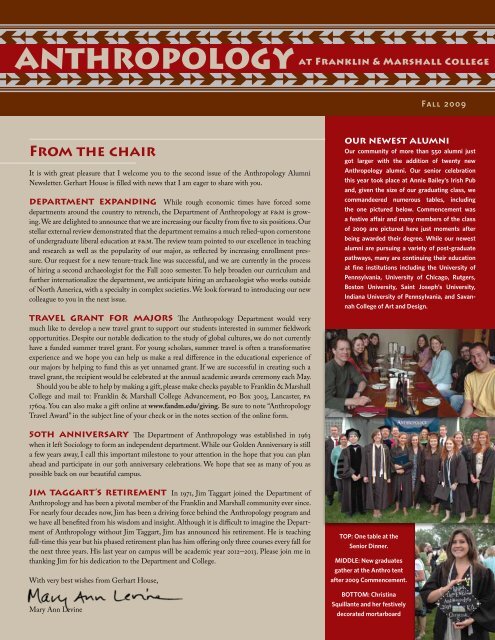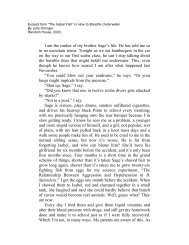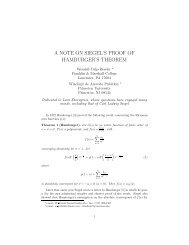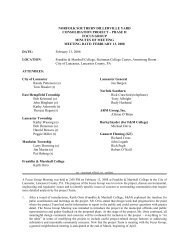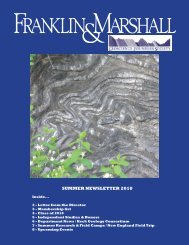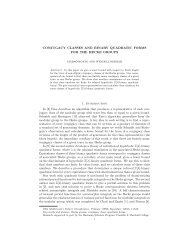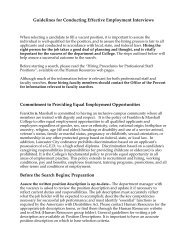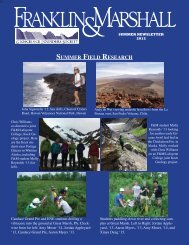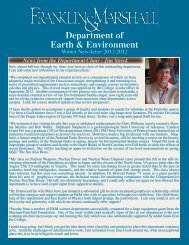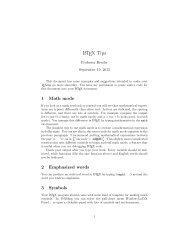From the chair - eDisk - Franklin & Marshall College
From the chair - eDisk - Franklin & Marshall College
From the chair - eDisk - Franklin & Marshall College
- No tags were found...
Create successful ePaper yourself
Turn your PDF publications into a flip-book with our unique Google optimized e-Paper software.
FALL 2009Anthropologyat <strong>Franklin</strong> & <strong>Marshall</strong> <strong>College</strong>Fall 2009<strong>From</strong> <strong>the</strong> <strong>chair</strong>It is with great pleasure that I welcome you to <strong>the</strong> second issue of <strong>the</strong> Anthropology AlumniNewsletter. Gerhart House is filled with news that I am eager to share with you.Department Expanding While rough economic times have forced somedepartments around <strong>the</strong> country to retrench, <strong>the</strong> Department of Anthropology at F&M is growing.We are delighted to announce that we are increasing our faculty from five to six positions. Ourstellar external review demonstrated that <strong>the</strong> department remains a much relied-upon cornerstoneof undergraduate liberal education at F&M. The review team pointed to our excellence in teachingand research as well as <strong>the</strong> popularity of our major, as reflected by increasing enrollment pressure.Our request for a new tenure-track line was successful, and we are currently in <strong>the</strong> processof hiring a second archaeologist for <strong>the</strong> Fall 2010 semester. To help broaden our curriculum andfur<strong>the</strong>r internationalize <strong>the</strong> department, we anticipate hiring an archaeologist who works outsideof North America, with a specialty in complex societies. We look forward to introducing our newcolleague to you in <strong>the</strong> next issue.Travel Grant for Majors The Anthropology Department would verymuch like to develop a new travel grant to support our students interested in summer fieldworkopportunities. Despite our notable dedication to <strong>the</strong> study of global cultures, we do not currentlyhave a funded summer travel grant. For young scholars, summer travel is often a transformativeexperience and we hope you can help us make a real difference in <strong>the</strong> educational experience ofour majors by helping to fund this as yet unnamed grant. If we are successful in creating such atravel grant, <strong>the</strong> recipient would be celebrated at <strong>the</strong> annual academic awards ceremony each May.Should you be able to help by making a gift, please make checks payable to <strong>Franklin</strong> & <strong>Marshall</strong><strong>College</strong> and mail to: <strong>Franklin</strong> & <strong>Marshall</strong> <strong>College</strong> Advancement, PO Box 3003, Lancaster, PA17604. You can also make a gift online at www.fandm.edu/giving. Be sure to note “AnthropologyTravel Award” in <strong>the</strong> subject line of your check or in <strong>the</strong> notes section of <strong>the</strong> online form.our newest alumniOur community of more than 550 alumni justgot larger with <strong>the</strong> addition of twenty newAnthropology alumni. Our senior celebrationthis year took place at Annie Bailey’s Irish Puband, given <strong>the</strong> size of our graduating class, wecommandeered numerous tables, including<strong>the</strong> one pictured below. Commencement wasa festive affair and many members of <strong>the</strong> classof 2009 are pictured here just moments afterbeing awarded <strong>the</strong>ir degree. While our newestalumni are pursuing a variety of post-graduatepathways, many are continuing <strong>the</strong>ir educationat fine institutions including <strong>the</strong> University ofPennsylvania, University of Chicago, Rutgers,Boston University, Saint Joseph’s University,Indiana University of Pennsylvania, and Savannah<strong>College</strong> of Art and Design.50th Anniversary The Department of Anthropology was established in 1963when it left Sociology to form an independent department. While our Golden Anniversary is stilla few years away, I call this important milestone to your attention in <strong>the</strong> hope that you can planahead and participate in our 50th anniversary celebrations. We hope that see as many of you aspossible back on our beautiful campus.Jim Taggart’s Retirement In 1971, Jim Taggart joined <strong>the</strong> Department ofAnthropology and has been a pivotal member of <strong>the</strong> <strong>Franklin</strong> and <strong>Marshall</strong> community ever since.For nearly four decades now, Jim has been a driving force behind <strong>the</strong> Anthropology program andwe have all benefited from his wisdom and insight. Although it is difficult to imagine <strong>the</strong> Departmentof Anthropology without Jim Taggart, Jim has announced his retirement. He is teachingfull-time this year but his phased retirement plan has him offering only three courses every fall for<strong>the</strong> next three years. His last year on campus will be academic year 2012–2013. Please join me inthanking Jim for his dedication to <strong>the</strong> Department and <strong>College</strong>.With very best wishes from Gerhart House,Mary Ann LevineTop: One table at <strong>the</strong>Senior Dinner.Middle: New graduatesga<strong>the</strong>r at <strong>the</strong> Anthro tentafter 2009 Commencement.BOTTOM: ChristinaSquillante and her festivelydecorated mortarboard
Anthropology at <strong>Franklin</strong> & <strong>Marshall</strong> <strong>College</strong>of Anthropology at <strong>the</strong> University of Rochester and am busily workingto turn my dissertation into a book.Val Yeager, 1999 Throughout <strong>the</strong> last ten years, I haveexplored a number of ways of applying my anthropological education,<strong>the</strong> most notable of which was assisting physicians in a clinicin Gugulethu, South Africa, and documenting <strong>the</strong> challenges ofadministering antiretrovirals to HIV-positive people in that community.This led me to <strong>the</strong> field I am currently working in, public health.I recognized <strong>the</strong> benefit of adding quantitative research skills to myapplied work and am currently a researcher and health policy doctoralstudent at <strong>the</strong> University of Alabama at Birmingham’s Schoolof Public Health. I study access to healthcare among <strong>the</strong> uninsuredand undocumented residents in Alabama, health IT, public healthpreparedness, and o<strong>the</strong>r policy issues. I recently won a national essaycontest held by <strong>the</strong> Naval Postgraduate School and was invited toMonterey, California, to present my proposal of linking poison controland public health for improved disaster communication and response.I am so thankful for my experiences at F&M — clearly it started me ona journey of learning!Jason Shellenhamer, 2001 Since graduation Ihave worked as a professional archaeologist for various firms in Pennsylvania,Maryland, and Washington, D.C. In 2004, I earned my master’sin applied anthropology from <strong>the</strong> University of Maryland; and for<strong>the</strong> last three years, I have been employed by Louis Berger Group inWashington, D.C. Many of my current contracts are with <strong>the</strong> NationalPark Service, where a major element of <strong>the</strong> projects include an interpretativeelement for broad audiences. I also currently hold a seat on<strong>the</strong> Board of Directors for Archaeology in <strong>the</strong> Community, a nonprofitthat focuses on bringing archaeology into local communitiesand providing individuals <strong>the</strong> opportunity to learn about <strong>the</strong>ir owncommunity’s history. I live in Annapolis, Maryland with my fiancé,Lisa Kraus, who is an archaeologist with <strong>the</strong> Maryland State HighwaysAdministration.Brian Estes, 2004 After graduation I spent a year teachingEnglish in Harbin and Shanghai, China. I went on to earn mymasters in anthropology from George Mason University, where Istudied <strong>the</strong> impact of social media on <strong>the</strong> US military institution. I’mnow working as a public policy associate and new media guru for <strong>the</strong>American Anthropological Association, but hope to return to graduateschool to pursue my interests in digital anthropology, informationstudies, and public health. I currently reside in Arlington, Virginia.Alumni Gift gracesgerhart HouseAn image of seven powerful Navajo Holy Persons now stands above<strong>the</strong> main doorway of Gerhart House. These supernatural beings arefound in <strong>the</strong> contemporary Navajo textile now hanging in <strong>the</strong> maincorridor, a weaving that was generously donated by Mark Rader ’63.These Holy People are <strong>the</strong> Yei Bicheii, often associated with wintercuring ceremonies. Holy People provide Navajo people <strong>the</strong> sustenance,guidance, and protection that is essential for life. Likewise, <strong>the</strong> art ofNavajo weaving provides weavers and <strong>the</strong>ir families material, social,and cosmological sustenance and protection.Many weavers draw inspiration from <strong>the</strong> cultural and natural environmentsin which <strong>the</strong>y live, and often say that <strong>the</strong>y “weave what <strong>the</strong>ysee.” The rich browns, vibrant greens, and gentle mauves within thisparticular weaving reflect <strong>the</strong> shades of earth and sky that are oftena part of <strong>the</strong> Southwestern landscape and <strong>the</strong> weavers’ world. Navajoweaving continues to be an important source of income for many familiesand is a practice that fortifies kin ties and that weaves generationstoge<strong>the</strong>r.The weaver of this particular textile, Maggie Mannie, follows <strong>the</strong>long-standing tradition of passing down weaving knowledge and skillsto maternal kin, as both her daughter and granddaughter now alsoweave. Interestingly, weaving has now become a key cultural symbol oflocal identity and plays a prominent role in <strong>the</strong> presentation of Navajoculture by weavers and community members.Thank you to Mark Rader for this magnificent textile!Jill Ahlberg Yohe earned her Ph.D. from <strong>the</strong> University of New Mexicofor her work on <strong>the</strong> social life of weaving in contemporary Navajo life andis currently a Visiting Scholar here in <strong>the</strong> Department of Anthropology at<strong>Franklin</strong> & <strong>Marshall</strong>.Kituhwan UpdateThe Kituhwan is an outlet for <strong>Franklin</strong> & <strong>Marshall</strong>’s anthropology students to display <strong>the</strong>ir research and criticalthought in pursuit of academic excellence. Recently, <strong>the</strong> journal became affiliated with <strong>the</strong> PhiladelphiaAlumni Writers House and joined <strong>the</strong> college’s o<strong>the</strong>r student publications in <strong>the</strong> Writers House community.The Kituhwan remains <strong>the</strong> only student run departmental journal on campus. The 2009–2010 issue of <strong>the</strong> Kituhwanis currently being created and is expected to be released in Spring of 2010.Submitted by Beth Bursick ’10


